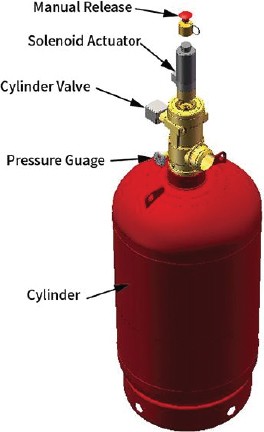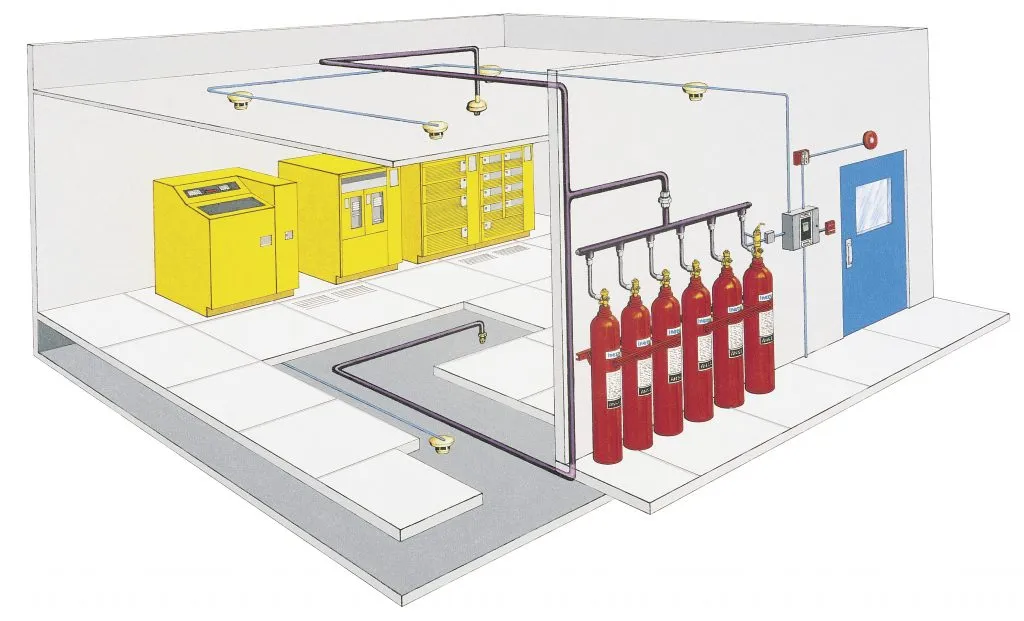FK-5112 fire suppression System- UL Listed

ES Series
EUROSAFE-1230 (FK-5112) Fire Extinguishing System
ES is a trademark of ES1230, Dodecafluoro-2-methylpentan-3-one, Another widely used extinguishing dean agent is FK-5-1-12. It is environmentally safe and best used in fire hazard areas containing Ar B, & C classes of fine. It has been approved by US EPA and ISO for its safe characteristic and fire extinguishing effectiveness.
ES1230 is good alternative clean agent for Halon 1301 replacement. ES FK-5-1-12 is guaranteed to meet the minimum NFPA 2001 Requirement as follows.
- Nominal Cylinder Size: 40-450 Ltr (DOT, TPED, GB)
- System Presssure: 25 Bar & 42 Bar
FK-5-1-12 Storage Components – Storage components consist of the cylinder assembly (s), which contains the FK-5-1-12 chemical agent, and the cylinder bracket(s), which holds the cylinder assembly securely in place.
FK-5-1-12 Distribution Components – Distribution components consist of the discharge nozzles used to introduce the FK-5-1-12 agent into a protected hazard along with the associated piping system used to connect the nozzles to the cylinder assembly.
Trim Components – Trim components complete the installation of the FK-5-1-12 system and consist of connection fittings, pressure gauge, low-pressure supervisory switch, electric valve actuator, and manual valve actuator
Slave Arrangement Components – Slave arrangement components consist of the pneumatic valve actuator(s), actuation check valve, bleed valve, pilot hose, and fittings required for a multiple cylinder (slave) arrangement.manual valve actuator.
Supplemental Components – Supplemental components include the discharge pressure switch and manifold check valve. They supplement the core equipment or complete a specific multicylinder configuration.
Control Panel – This device monitors the condition of the electric actuator, detectors, warning devices, cylinder pressure, and any manual release and abort stations. All electric or electronic devices must connect to the control panel in order to function.

Cylinder Valve
The automatic release of HFC-227ea is controlled by a forged brass, differential pressure operated cylinder valve connected to the neck of the cylinder. The valve assembly is shipped with an anti- recoil safety device installed in the discharge outlet and chained to the cylindervalve.
Dip Tube
A threaded, rigid dip tube extends from the cylinder neck down to its bottom.
Cylinder
The light walled, welded seam cylinder is manufactured according to the requirements of TPED. Internal neck threads allow connection of the cylinder valve. The cylinder is designed for mounting in a vertical position only

Valve Actuation Connection
A threaded connection located on top of the cylinder valve serves as the attachment point for the electric (primary) or pneumatic (slave) valve actuator.
Pressure Gauge Connection
A female connection serves as the attachment point for the pressure gauge. It is fitted with an internal check valve to allow removal of the gauge while the cylinder is pressurized.
Pilot Actuation Port
A 1/4 in (8 mm) FNPT connection (shipped with a removable plug) provides a means of applying actuation pressure to the slave cylinder(s). This can also be used for attachment of the discharge pressure switch in single cylinder arrangements. The port is pressurized only during the 10 second discharge period.
FK-5-1-12
CHEMICAL PROPERTIES
ES is a trademark of ES1230, Dodecafluoro-2-methylpentan-3-one, Another widely used extinguishing dean agent is FK-5-1-12. It is environmentally safe and best used in fire hazard areas containing Ar B, & C classes of fine. It has been approved by US EPA and ISO for its safe characteristic and fire extinguishing effectiveness.
ES1230 is good alternative clean agent for Halon 1301 replacement. ES FK-5-1-12 is guaranteed to meet the minimum NFPA 2001 Requirement as follows.

System
CONSIDERATIONS
Although the EPA Significant New Alternative Program (SNAP) lists FK-5-1-12 as acceptable for occupied spaces, NFPAStandard 2001 and SNAP list the following guidelines for human exposure;
The discharge of HFC-FK-5-1-12 into a hazard may reduce visibility for a brief period. FK-5-1-12 may cause frostbite if liquid discharge or escaping vapor contacts the skin.
When FK-5-1-12 is exposed to temperatures greater than 1300 ° F (700° C), the by product Hydrogen Fluoride (HF) will be formed. FK-5-1-12 systems are designed to discharge in 10 seconds or Less in order to minimize the amount of HF formed.
The FK-5-1-12 Material Safety Data Sheet (MSDS) should be read and understood prior to working with the agent.
A cylinder containing FK-5-1-12 should be handled carefully. The anti-recoil safety device must be in place at all times when the cylinder is not connected to the discharge piping and restrained.
| IUPAC Name | 1,1,1,2,2,4,5,5,5-Nonafluoro-4-(trifluoromethyl)-3- pentanone |
| ASHRAE Designation | FK-5-1-12 |
| Synonym | Dodecafluoro-2-methylpentan-3-one |
| CAS Registry Number | 756-13-8 |
| CAS Registry Number | 756-13-8 |
| Chemical Formula | CF3CFC(O)CF(CFs)2 |
| Molecular Weight | 316.04 |
| Boiling Point at 760 mmHg | 120.2°F (49°C) |
| Critical Temperature | 335.6°F (168.66°C) |
| Critical Density | 39.91 lbm/ft (639.1 kg/m3 |
| Critical Pressure | 270.44 psi (1,865 kPa) |
| Critical Volume | 0.0251 ft3/Ibm (494.5 cc/mole) |
| Viscosity, Liquid at 77°F (25°C) | 1.27 Ib/ft-hr (0.524 cP) |
| Solubility in Water at 70°F (21.1°C) | <0.001% by weight |
| PROPERTY | REQUIREMENT |
| Purity | 99.0% (minimum) |
| Water Content (by weight) | 0.01% |
| Non-Volatile Residue (g/100 ml) | 0.05 |
| IMPACT | |
| Global Warming Potential (GWP) | 1 |
| Atmospheric Lifetime (ATL) | 0.014 years |
SYSTEM DESCRIPTION
The liquefied compressed gas FK-5-1-12/Novec 1230 is odorless and colorless. It is stored as a liquid and dispensed as a colorless, electrically non-conductive vapor that is clear and does not obscure view into the hazard. It leaves no residue and has a low enough toxicity to be used in populated settings at the recommended concentration. FK-5-1-12/Novec 1230 uses a combination of chemical and physical processes to extinguish a fire.
FK-5-1-12/Novec 1230 offers excellent fire protection in a wide range of applications, including sensitive electrical equipment and industrial applications involving flammable liquids. The chemical FK-5-1-12/Novec 1230 is utilized in total flooding fire suppression systems. They System are Designed as per NFPA.

COMPONENTS OF PIPE NETWORK FK-5-1-12/NOVEC 1230 FIRE SUPPRESSION SYSTEMS
Cylinder, container valve (with pilot valve, pressure indicator), dip tube, etc.
Assure one-way flow of fire suppression agent, to prevent backflow.
Connect the cylinder valve and liquid check valve.
Fitted on the manifold to relieve higher pressure.
Guide fire suppression agent into different distribution pipe networks.
Bottle, container valve, electromagnetic drive device, pressure gauge.
Assure one-way flow of starting gas, to prevent backflow.
For accumulated starting gas release so as to avoid malfunction of the system.
Fitted at the end of the pipe network to discharge fire-suppressing agent.
Control panel, smoke and heat detector, fire alarm, discharge indicator light, etc.
ADVANTAGE
- Very swift fire suppression. Reach extinguishing level ≤10s.
- Safe to people. People is safe when exposed at the FK-5-1-12/Novec 1230 gas discharge level.
- Low extinguishing concentration. Nearly no obscure to vision in person evacuation.
- Easy to clean. No residue left, and minimize damage to sensitive equipment.
- Environment friendly. Zero ozone depletion potential and zero global warming potential.
- Simple installation, with small storage space.
WORKING PRINCIPLE
The fire extinguishing system is under automated control when the control mode selection key on the automatic fire alarm and fire extinguishing controller is set to the “auto” position. When a fire breaks out in the protective zone, the temperature and smoke detectors transmit a fire signal to the automated fire alarm and extinguishing control. Following the device’s logic analysis, it transmits a combined sound and light alert signal, as well as a linkage instruction to close the linkage device. After a brief delay, a fire extinguishing order is delivered, the beginning valve is opened to release the starting gas, and the starting gas is released via the control gas pipeline valves and container valves.